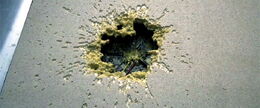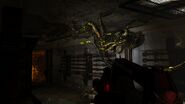
The acidic effect of Xenomorph blood
Xenomorph blood is a highly acidic substance that can burn through virtually any material in short order. Using potent acid for blood is the Xenomorph's primary defense mechanism, and one of the species' most recognizable physical attributes.
Purpose
Xenomorph acidic blood is primarily a passive defense mechanism; while it does not pose a threat directly, killing or harming an Alien with any attack that breaks the skin will cause the acid to spill, potentially harming the attacker or, as would be the case on a starship, breaching a vessel's hull.[1] This makes killing even a single Xenomorph a difficult proposition if only conventional projectile weapons are available, especially when encountered on board a starship.
Despite its typically passive nature, certain castes of Xenomorph have evolved to use their acid blood in a more offensive manner. Warriors, for example, have developed a highly pressurised bloodstream that can cause them to physically explode if sufficiently damaged, showering the surrounding area in acid.[2] Boilers intentionally use a similar process as a means of attack, rushing targets before suicidally rupturing their bodies and fatally drenching their victims in blood.[3] Drones have the ability to spit their blood at targets, although the quantity is small and consequently this means of attack is normally used to wound and disable targets rather than kill them.[4][5] The spitting ability is used more aggressively by Praetorians, which are capable of spitting lethal quantities of their blood significant distances, giving them a dangerous ranged attack other Xenomorphs do not possess.[6]
Xenomorphs also use their blood in more tactical ways. Facehuggers have the ability to secrete small quantities of their blood in order to burn through obstructions and gain access to hosts.[1][4] Similarly, fully grown Xenomorphs are shown to have an understanding of their blood's properties beyond simply spitting it at victims, and have been known to deliberately mutilate or even kill each other in order to use these properties to overcome obstacles.[5][7]
One slightly more outlandish theory, proposed by Weyland-Yutani scientists, is that the acidic blood may play a role in how the Xenomorphs digest their food, similar to some insect species.[8]
Composition
Xenomorph blood is a molecular acid.[2] While incredibly potent, it quickly oxidises in air and is subsequently rendered neutral.[1] It is typically a dull yellow in color, occasionally with hints of green. While generally accepted as the creature's blood (and typically described as such), some have suggested that, at least at the Facehugger stage, the acid is not blood but rather a defensive fluid maintained under pressure between a double layer of skin.[9][10]
The exact composition of the the Xenomorph's acid blood remains a mystery, with it's incredibly corrosive properties no doubt limiting the degree to which it may be studied. It has been theorized that the blood could be some type of "hydrosulfuric" or hydrochloric acid composition due to its corrosiveness and its conspicuously toxic effects on living human tissue. It has also been theorized that the Aliens are immune to their own acidic blood due to an endobiological build-up, similar to the human stomach's ability to protect itself from its own digestive fluids.[11] This idea has been pushed further with the suggestion that the Xenomorph's protection system against its own toxic hydrofluoric acid is essentially a bio-organically produced Teflon insulation within its body, since polytetrafluoroethylene (PTFE, or Teflon), being a fluorine-based compound, does not react with hydrofluoric acid.[11] In the film Alien vs. Predator this is shown to be the case, as a Predator uses Xenomorph chitin to make armor for Alexa that protects her from Alien blood.[7]
Other theories include the possibility of the blood being a fluorocarbon or chlorofluorocarbon compound; this would serve to explain why Xenomorphs that have been set alight will sometimes explode violently, as fluorocarbons are incredibly reactive with fire.[8] Another suggestion proposes that the blood may be comparable to a bio-organic battery and that it is the source of the Xenomorph's energy, although how the creatures may "recharge" this battery remains a mystery.[8]
Defense Against Xenomorph Blood
While Xenomorph acid is notoriously corrosive, it seems there are at least some materials that can resist it. Most notably, much Predator technology is constructed of metals that are immune to the effects of Xenomorph blood.[7][12] Predator blood itself is also shown to be able to partially neutralize the acidity of Alien blood.[13] However, human technology in this regard remains in its infancy. While basic systems have been prototyped (including the Apesuit acid-proof body armor) mankind has yet to develop truly effective methods for negating the corrosive effects of Alien blood.
Trivia
- The effects of acidic blood are portrayed with wildly varying consistency in the films. In Alien, the blood (from the Facehugger attached to Kane) is seen to be capable of melting through two decks of the Nostromo in mere seconds, yet when Ripley shoots the fully-grown Alien with a harpoon gun at the end of the film, the spilled blood fails to melt the harpoon and free the creature. In Aliens, Corporal Hicks' armor is destroyed by acid blood, yet at many other points the substance does not damage the walls and floors around dying creatures like it should. In Alien Resurrection, Ripley 8 has acid blood capable of melting through steel and toughened glass, yet it has no effect on the surgical implements used to operate on her at the start of the movie.
- Beyond the acidic effects of the blood itself, the Xenomorph circulatory system is never examined in any detail in the film series. However, the novelization of Alien Resurrection states that Xenomorphs have a heart that beats considerably faster than that of a human.[14]
- The clone Ripley 8 also possessed acidic blood thanks to the inclusion of Xenomorph DNA in her system, although it was nowhere near as potent as that of Xenomorphs.
Gallery
References
- ↑ 1.0 1.1 1.2 Dan O'Bannon, Ronald Shusett (writers) and Ridley Scott (director). Alien (1986), 20th Century Fox [DVD].
- ↑ 2.0 2.1 James Cameron (writer and director). Aliens (1986), 20th Century Fox [DVD].
- ↑ Aliens: Colonial Marines (2013), Gearbox Software [Microsoft Windows, PlayStation 3, Xbox 360].
- ↑ 4.0 4.1 Vincent Ward (writer) and David Fincher (director). Alien3 (1992), 20th Century Fox [DVD].
- ↑ 5.0 5.1 Joss Whedon (writer) and Jean-Pierre Jeunet. Alien Resurrection (1997), 20th Century Fox [DVD].
- ↑ Aliens vs. Predator (2010), Rebellion [Microsoft Windows, PlayStation 3, Xbox 360].
- ↑ 7.0 7.1 7.2 Paul W.S. Anderson (writer and director). Alien vs. Predator (2004), 20th Century Fox [DVD].
- ↑ 8.0 8.1 8.2 Lee Brimmicombe-Wood. 'Aliens: Colonial Marines Technical Manual', p. 140 (1996), HarperPrism.
- ↑ Alan Dean Foster. Alien novelization, p. 95 (1979), Warner Books, Inc..
- ↑ Alan Dean Foster. Alien novelization, p. 103 (1979), Warner Books, Inc..
- ↑ 11.0 11.1 Brothers Strause, Ronald Shusett. Science of the Alien (2007), 20th Century Fox [DVD].
- ↑ Dan O'Bannon, Ronald Shusett, Jim Thomas, John Thomas (writers) and The Brothers Strause (directors). Aliens vs. Predator: Requiem (2007), 20th Century Fox [DVD].
- ↑ Perry, Steve & Perry, Stephanie. Aliens vs Predator: Prey, p. 259 (1994).
- ↑ Ann Crispin. Alien Resurrection novelization, p. 14 (1997), Warner Books, Inc..



